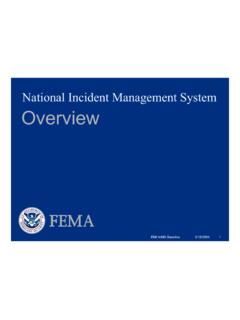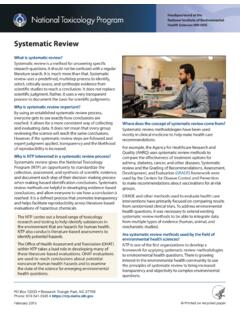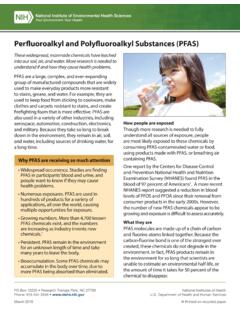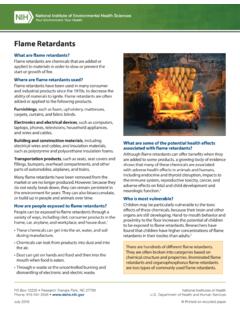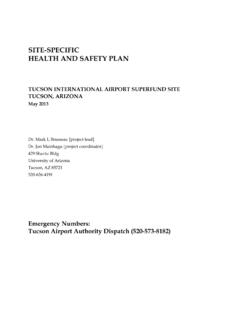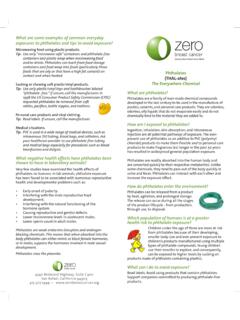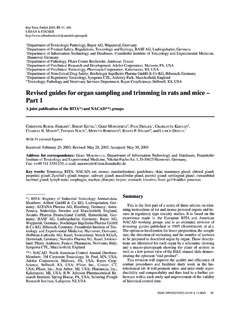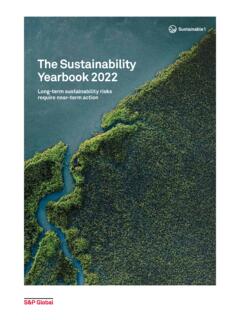Transcription of Chapter 6: Capacity Building - National Institute of ...
1 Partnerships for Environmental Public Health Evaluation metrics Manual Chapter 6: Capacity Building Chapter Contents Introduction .. Activities .. Outputs .. Case Study .. Summary of metrics .. 150 156 172 179 189 192 149 150 CapacityBuilding Chapter 6: Capacity Building Introduction Capacity building38 can be integral to the promotion and sustainability of environmental health programs. It is the process that improves the ability of a person, group, organization, or system to meet its objectives or to perform better. 39 NIEHS has defined Capacity Building as any activity that improves an entity s ability to achieve its mission 40 and the engagement of existing and new stakeholders [as well as] training for a variety of audiences. 41 By Building Capacity , PEPH projects can prolong and multiply positive health effects and partner benefits, thus adding value to outcomes.
2 Sustained Capacity can make individuals and organizations more competent, not only by addressing issues of direct interest to a project, but also by providing access to more resources, knowledge, and skills for addressing additional Capacity Building generally includes increasing organizational Capacity , physical and communication infrastructure, and individuals knowledge and skills. Increased Capacity can lead to initiation and maintenance of a reduction in, or elimination of, environmental health exposures and risks. In this Manual, we organize our discussion of Capacity Building into three categories: Organizational Capacity : Some organizations start from scratch and need to begin with Building basic organizational structures. Others have existing frameworks that some partners have to learn to navigate. Writing down policies and procedures can help establish and transfer institutional knowledge and can contribute to organizational stability. Obtaining and Building organizational Capacity can increase partners abilities to accomplish their goals.
3 For example, developing operating norms and procedures that promote mutual respect, appreciation for differences, and opportunities for universal participation can facilitate effective In addition, nurturing human resources can lead to greater retention of staff and an increase in interest, motivation, and creativity among partners. Physical and communication infrastructure: Physical infrastructure is the basic equipment and Building space needed for the operation of a PEPH project. Communication infrastructure is the underlying base for an organization s data, voice, and video systems. Knowledge and skills: A range of strategies and practices are used in an organization to identify, create, represent, distribute, and enable adoption of insights and experiences that can occur to individuals. Knowledge is often reflected in the understanding of organizational processes or practices, as well as in subject matter expertise. Skills are defined as the proficiency, facility, or dexterity that is acquired or developed through training or experience by individuals.
4 38 For more information on Capacity Building , see Alliance for Nonprofit Management. 2010. About Capacity Building . 39 Brown L, LaFond A, Macintyre K. 2001. Measuring Capacity Building : MEASURE Evaluation Project for USAID. Available: [accessed 19 January 2021]. 40 Environmental Health Perspectives, International Program. 2010. Capacity Building . 41 NIEHS. 2008. Partnerships for Environmental Public Health: RFI Executive Summary. 12. 42 Hawe P, Noort M, King L, Jordens C. 1997. Multiplying health gains: The critical role of Capacity - Building within health promotion programs. Health Policy 39(1): 29-42. 43 Israel BA, Schulz AJ, Parker EA, Becker AB. 1998. Review of community-based research: Assessing partnership approaches to improve public health. Annu Rev Publ Health 19: 185. Capacity Building : Introduction 151 CapacityBuilding Using This Chapter This Chapter develops approaches and metrics for evaluating Capacity among PEPH grantees, which includes various types of organizational and individual partners.
5 Many of the approaches partners might take to assess resources, knowledge, and skills of partner groups and individuals might be the same (such as asking questions and discussing approaches). However, the actual Capacity that these groups and individuals develop over the course of the project might differ. The next section in this Chapter discusses how grantees can conduct Capacity Building at various levels: For the project as a whole. For a particular group within a project (community organizations, researchers, health professionals, policymakers, and decision-makers). For individuals within one of these groups. The remainder of this Chapter provides approaches and metrics for assessing Capacity Building activities, outputs and impacts in PEPH programs. Although approaches might be similar, the actual capacities addressed might vary across the various types of partners and might evolve over the course of a project. These approaches and metrics are generally drawn from PEPH examples and are intended to stimulate readers thoughts and ideas.
6 They are not intended to be a prescriptive set of steps to be followed. Levels of Capacity Building PEPH programs typically focus on Capacity Building of community residents, researchers, health professionals and decision-makers so that these individuals and groups can work together on environmental public health projects. These individuals and groups have been identified as participants in various PEPH projects, and each has different needs, skills, and resources. This section identifies specific capacities that PEPH partners can emphasize for the four different target groups. Community Organizations Local communities are one of the most common targets of PEPH Capacity Building efforts. Capacities sought by community organizations can include: Environmental health tools and skills. Knowledge of community health indicators and environmental exposures. Ability to assess community health. Ability to communicate health impacts, risks, and data to citizens.
7 Ability to perform intervention and prevention strategies. Research process tools and skills. Knowledge of the research process. Grantsmanship (the ability to write grants, track, and manage funds, etc.).44 Ability to contribute to research question development. Ability to participate in data collection, analysis, and outreach. Systematic program evaluation. 44 For more information on writing grant proposals for Capacity Building , see Chandler S. 2008. Writing Proposals for Capacity Building . The Grantsmanship Center. Capacity Building : Introduction 152 CapacityBuilding Researchers Historically, academic institutions rarely had structures to foster or reward researchers for partnering with communities, decision-makers, or health care professionals. Because this is an evolving area for academic researchers, they may benefit from Building a Capacity to conduct collaborative research. Capacity Building for researchers might focus on training to work effectively with communities, regulators, legislators, public health officials, decision-makers and other Researchers could need formal training or cultural immersion along with other forms of Capacity Building to work in integrated, interdisciplinary teams involving community members, social scientists, economists, urban planners, community organizations, health professionals, decision-makers and others.
8 Capacity Building for researchers could involve the following skills and knowledge areas: Ability to provide training, mentoring, and infrastructure for the individuals in their organization. Ability to conduct collaborative, equitable research projects that engage other partners in research, using, for example, the principles of community-based participatory Ability to facilitate the dissemination of findings and knowledge gained. Knowledge of scientific translation practices. Ability to translate scientific information into regulations and policies for the benefit of community members. Knowledge of cultural sensitivity and norms. Ability to interact in a culturally appropriate way with other partners. Health Professionals Health professionals, such as doctors, nurses, clinicians, state and local health officials, as well as other public health professionals, are significant partners in PEPH projects. Because they are on the front line within the community, it can be important for health professionals to have state of the art understanding of environmental health-related issues.
9 Yet clinical and public health professionals often lack formal environmental health and exposure Because they often have the greatest interaction with the public, nurses in particular can play a crucial role in environmental health. Nurses serve in a variety of specialty settings ranging from public health to acute care and are often the first point of contact for the public when environmental health concerns arise. Community members see nurses as trusted sources of information, and yet, like doctors, nurses often have not received any environmental health 45 For more information on Capacity Building in research projects, see Breen CM, Jaganyi JJ, van Wilgen BW, van Wyk E. 2004. Research projects and Capacity Building . Water SA 30(4): 429-434. 46 Israel BA, Schultz AJ, Parker EA, Becker AB. 1998. Review of community-based research: assessing partnership approaches to improve public health. Annu Rev of Publ Health 19: 173-202. 47 Mccurdy LE, Roberts J, Rogers B, Love R, Etzel R, Paulson J, Witherspoon N, Dearry A.
10 2004. Incorporating environmental health into pediatric medical and nursing education. Environ Health Perspect 112(17). 48 Pope AM, Snyder MA. 1995. Nursing, Health & the Environment: Strengthening the Relationship to Improve the Public s Health. Institute of Medicine ( ), Committee on Enhancing Environmental Health Content in Nursing Practice. Capacity Building : Introduction 153 CapacityBuilding Additionally, local and state health officials often play a critical role in public health monitoring and intervention in environmental exposure situations. These officials can provide helpful insight into the environmental health implications of policy and regulatory decisions. Common ways to build the Capacity of health professionals are to offer them continuing education units,49 to involve them directly as partners at the commencement of a PEPH program, to provide literature for use in their offices, and to develop talking points for them to pass on to patients.

